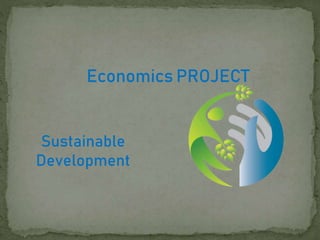Slideshow share karo.pptx
- 2. Introduction Definition How Sustainability Works Objectives of sustainable development Pillars of sustainable development Goals Importance of Sustainable Development Examples of Sustainable Development What Prevents it From Happening? Conclusion References
- 3. Sustainable development can be defined as an approach to the economic development of a country without compromising with the quality of the environment for future generations. In the name of economic development, the price of environmental damage is paid in the form of land degradation, soil erosion, air and water pollution, deforestation, etc. This damage may surpass the advantages of having more quality output of goods and services.
- 4. Sustainability encourages businesses to frame decisions in terms of environmental, social, and human impact for the long-term, rather than on short-term gains such as next quarter's earnings report. It influences them to consider more factors than simply the immediate profit or loss involved. Increasingly, companies have issued sustainability goals such as commitment to zero-waste packaging by a certain year, or to reduce overall emissions by a certain percentage. These companies can achieve their sustainability needs by cutting emissions, lowering their energy usage, sourcing products from fair-trade organizations, and ensuring their physical waste is disposed of properly and with as small a carbon footprint as possible.
- 5. Economic growth Environmental protection Social inclusion
- 6. 2. Agricultural Requirement A growing population means agriculture must catch up. Finding ways to feed more than 3 billion people can be staggering. If the same unsustainable cultivation, planting, irrigation, spraying, and harvesting techniques are utilized in the future, they might prove to be financially burdening considering fossil fuel resources are projected to run out. Sustainable development focuses on sustainable agricultural methods such as effective seeding techniques and crop rotation to promote high yields while maintaining the integrity of the soil, which produces food for a large population.
- 7. 4. Financial Stability Sustainable development practices have the ability to create more financially sustainable economies across the globe. Developing countries that can’t access fossil fuels can leverage renewable forms of energy to power their economies. From the development of renewable energy technologies, these countries can create sustainable jobs as opposed to finite jobs based on fossil fuel technologies.
- 8. Wind Energy Wind energy is energy harnessed from the motion of wind using wind turbines or windmills. Wind energy is renewable, which means it’s never-ending and can be used to substitute energy at the grid. This makes it a good sustainable development practice.
- 9. The first is that for many aspects of development, using sustainable methods and materials is expensive. While the long-term cost of sustainability does prove to be less expensive than traditional development, the creation of a sustainable project may be far more expensive in the first phase. The second major issue is that there is not a generally accepted need for sustainable development. This is an education issue that may take many years to resolve.
- 10. Sustainable development is largely about people, their well- being, and equity in their relationships with each other, in a context where nature-society imbalances can threaten economic and social stability. Because climate change, its drivers, its impacts and its policy responses will interact with economic production and services, human settlements and human societies, climate change is likely to be a significant factor in the sustainable development of many areas (e.g., Downing, 2002). Simply stated, climate change has the potential to affect many aspects of human development, positively or negatively, depending on the geographic location, the economic sector, and the level of economic and social development already attained (e.g., regarding particular vulnerabilities of the poor, see Dow and Wilbanks, 2003









